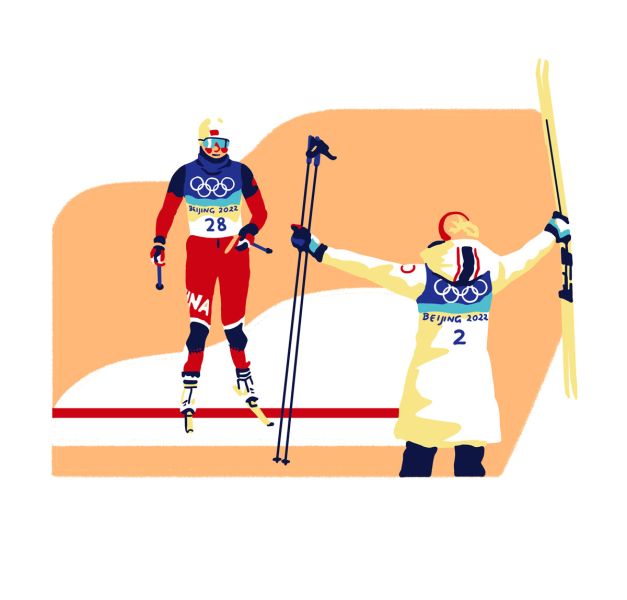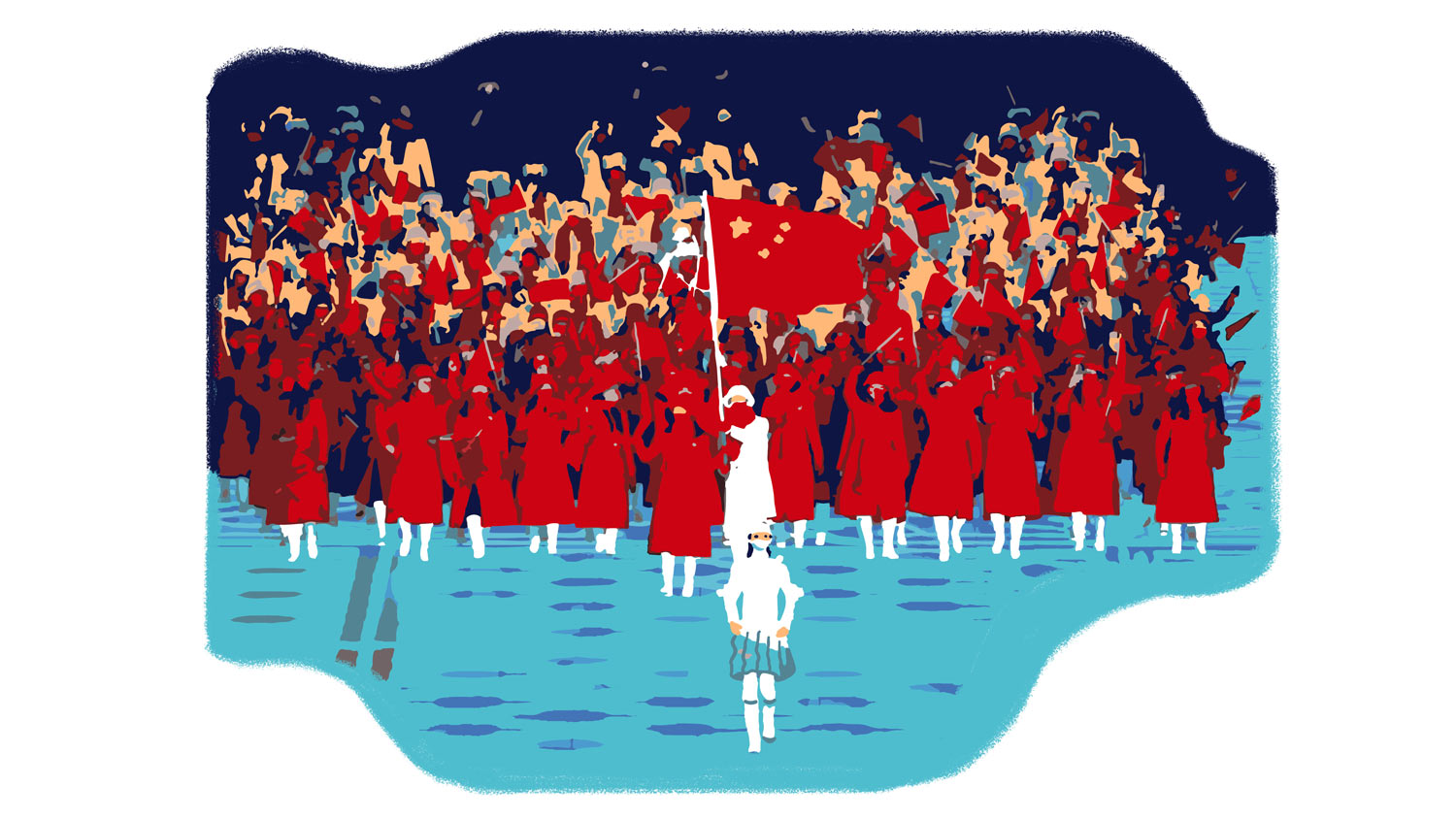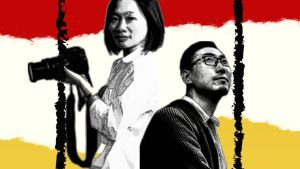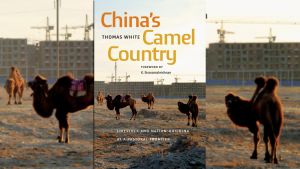
Winter Olympic Dreams and Foreign Friends
With outstretched arms ready to provide a hug, the winner of the 2022 Beijing Winter Olympics cross-country skiing women’s 30-kilometre Mass Start welcomed the last contestant as she reached the finish line. As the two embraced, Norwegian Olympic champion Therese Johaug consolingly told the last-place finisher, Dinigeer Yilamujiang of the Chinese team: ‘Be proud of yourself! I know how hard you’ve worked.’ It was not the first time the two women had met. Members of China’s cross-country skiing and biathlon teams trained on the same tracks as Norwegian winter sports athletes in the years leading up to the Olympic Games in Beijing, and Norwegian skiers had watched their Chinese peers develop from insecure novices to world-class contestants.
Yilamujiang was one of 200 Chinese athletes who trained in Norway under the Sino-Norwegian sports agreement signed in 2017. The agreement committed Norway to organising training camps for Chinese talent, dispatching skiing experts to China to train Olympic contestants, and helping China promote the development of winter sports (Regjeringen 2017). When the 2022 Olympic cauldron was lit, more than 100 Norwegian coaches and other support staff had participated in the training of Chinese athletes (Norges Idrettsforbund 2020). In the year after the Beijing Winter Olympics, we interviewed 15 of these coaches to capture their experiences as foreign experts hired to produce Chinese athletic champions. By the time their assignments had ended, most felt in equal parts invested in the athletes’ future and frustrated with the Chinese sports bureaucracy.
Same Bed, Different Dreams
Norwegian and Chinese interests in a successful collaboration were motivated by different goals. On the Chinese side, the cooperation with Norway was part of heavy investment in snow sports leading up to the 2022 Winter Olympics. The General Administration of Sports of China (GAS) increased expenditure on winter sports by 23 per cent per year on average after Beijing was awarded the games (GAS 2021). Even in 2020, when the Covid-19 pandemic limited travel and the hosting of events, China’s national winter sport centre spent as much as RMB1.16 billion on ‘physical training’ (体育训练), including programs to train Chinese athletes abroad—travel for which was not halted during the pandemic. Foreign coaches continued to be invited to China, while Norway was a main destination for prospective Chinese Olympians. Chinese athletes from sports schools and provincial teams attended Norwegian training camps in cross-country skiing, biathlon, and ski jump (Norges idrettsforbund 2020).
Norway’s efforts in the collaboration had both commercial and cultural aims. A bilateral China–Norway sports agreement signed in 2017 marked the end of years of diplomatic chill and trade sanctions that had ensued when Chinese dissident Liu Xiaobo was awarded the Nobel Peace Prize in Oslo in 2010. Besides improving trade relations, Norwegian politicians hoped to strengthen the global status of ski sports by nurturing Chinese elite contestants. Strong performance in cross-country skiing is a source of national pride in Norway, but a lack of international competition threatened to undermine the legitimacy of the sport. What better way to prove cross-country skiing’s global relevance than to train Chinese athletes and give a population of 1.4 billion a stake in it?
Norwegian coaches, several of whom were former Olympians, were initially astonished with the progress they witnessed in the Chinese athletes, who adapted well to a new cultural environment and Norwegian coaching principles. Some athletes had started to ski only in their late teens and disproved the idea that an early start was a precondition for success in snow-based sports. Chinese President Xi Jinping attributed the potential for such rapid improvement to China’s strong national sports system: ‘Because we have a “nation-wide support for sport-system” [举国体制], with all aspects planned and optimised, we can inject a lot of fresh blood into the ice and snow sports in a short time to overcome talent shortage difficulties’ (Zheng et al. 2022). This idea of a virtually endless supply of Chinese talent and a system based on disposability would eventually become a source of divergence between sports professionals in China and Norway, wherein the latter claimed that unrelenting pressure and constant competition obstructed athletic development.
An Aspiring Winter Sports Superpower
Cross-country skiing and biathlon are considered niche sports in most countries, and many consider the commercial entertainment value of these ski sports to be low. This begs the question: why would China invest so many resources in sports that are hardly practised in China and about which few people around the world care?
An obvious answer is that China wanted to do well when the Winter Olympics were held on its home turf. At the 2008 Beijing Summer Olympics, China won the most gold medals of all nations and the second most medals in total after the United States. Sports bureaucrats faced high expectations for the feat to be repeated when the Winter Olympics were brought to China. In addition, China had promised the International Olympic Committee (IOC) in its bid that granting the games to Beijing would help popularise winter sports, the viewership and commercial value of which lag far behind the summer Olympic sports.
China’s dedication to producing Olympic winners started long before it became a host country for the games. Under Deng Xiaoping’s leadership, elite sports were used to highlight the values of individualism and structured competition, and as a vehicle for stirring national pride (Brownell 1995). At the 1984 Los Angeles Games, China took home an astonishing 15 gold medals and finished fourth in the overall medal tally. The Olympic Games were commercialised in the 1980s, which coincided with China’s Reform and Opening-Up policies. The Los Angeles Games provided a spectacular and attractive enactment of a market economy at a time when the Chinese public and leaders struggled to grasp what market reforms meant (Brownell 2021). China’s success at the games signalled to people both at home and abroad that the country was ready to engage on the world stage. More recent investments in winter sports in China were made with a similar rationale to those in the summer games (Guo and Xu 2023). The Chinese sports system lacked the necessary knowledge and skills to secure Olympic medals in snow-based sports. The Norwegian coaches we interviewed were fascinated by the idea of working with talented athletes who had little or no experience with winter sports. Those who were assigned participants to be transferred from summer sports had to start by explaining the basics. ‘This is cross-country skiing,’ one of them said to a group of potential Chinese recruits while showing a video of Norwegian athletes climbing a hill on cross-country skis. ‘The point is to move from A to B as quickly as possible assisted by skis and ski poles.’

Foreign Friends and Adversaries
China has developed elite sports through the strategic employment of foreign expertise with its ‘invite in and go out’ (引进来、走出去) strategy, whereby foreign coaches have been recruited to come to China and overseas training is organised for Chinese athletes (Zheng et al. 2019). Such efforts were intensified in the leadup to the 2008 Olympic Games, which saw the launch of a comprehensive program to recruit foreign coaches and organise overseas training under the GAS. The program indicated the GAS’s determination to enhance China’s elite sport performance in select disciplines by applying foreign expertise. It also enabled China to introduce new sports in which it had no prior domestic experience or coaching capacity.
Foreign elite coaches who train Chinese athletes have a symbolic as well as a practical function. Their commitment demonstrates that Chinese and foreigners can unite around the common goal of making China’s athletes excel. China employs the trope of friendship to describe its sports cooperation, and assistance from abroad to strengthen the country’s sporting power is often cited as evidence that fair-minded foreigners support China’s peaceful rise. A case in point is the press release from the Chinese Embassy in Oslo after the Olympics, which acclaimed Therese Johaug’s ‘patient waiting’ for Dinigeer Yilamujiang by the finish line (Chinese Embassy in Oslo 2022). The dispatch recounted instances of mutual appreciation between Chinese and foreigners during the Olympics and thanked Norwegian sports professionals for their valuable support in the development of winter sports in China. A sentimental heading set the tone: ‘Let warmth and humanity shine.’
The notion of friendship is central to the vocabulary of Sino-foreign exchanges under the Chinese Communist Party (CCP). The Chinese Government and media consistently describe China’s relationship with the world in terms of how friendly foreign actors are towards it. The language of friendship embodies the idea of the opposite: an outside world that is populated by adversaries of Chinese prosperity. Portrayals of Western countries as either antagonistic or friendly are not diametrically opposed; both underscore the imperative of growing China’s power and dominance in the global system. Making friendliness the key parameter for evaluating Sino-foreign interaction precludes the possibility of exchanges that are open-ended and governed by values other than being for or against China, as Brady (2003: 249–53) has argued. The perception of the world as divided into friends and foes was explicitly articulated in the Chinese Embassy’s press release, which was subtitled ‘The Embassy Spokesperson’s Response to Certain Distorted Coverage in Norwegian Media on Beijing 2022 Winter Olympics’. The appreciation of the friendship is simultaneously a confirmation that the People’s Republic of China operates in a hostile global environment in which vigilance—sometimes even belligerence—is necessary for the country’s self-preservation. ‘Placing Sport at the Service of Humankind’
The Olympic Charter states: ‘The goal of Olympism is to place sport at the service of the harmonious development of humankind, with a view to promoting a peaceful society concerned with the preservation of human dignity’ (IOC 2021). Modernism and the belief that progress depends on ideological guidance are central to both the Olympic movement and China under the CCP. The Olympic movement’s focus on staging competitions between nations while using a set of vague but grandiose terms to propagate the virtues of globalism fits well with political discourse in post-reform China. Tangible results in Olympic arenas, however, require more than just rhetoric.
China has built a national sports bureaucracy and funding system around the overall goal of achieving ‘Olympic glory’ (奥运争光). The Sino-Norwegian coaching collaboration was embedded in this system. At the top is the GAS, which devised its first Olympic strategy in 1985 and subsequently released ‘Strategic Olympic Glory Plans’ every 10 years (Zheng et al. 2019). These plans legitimise the status of elite sport as a policy priority. A system of provincial sports bureaus with teams that compete against each other nationally was set up under the GAS, and it uses results from the National Games of China to allocate resources to and govern the provincial bureaus (Ma and Kurscheidt 2019). The provincial teams are also expected to prioritise sports that are seen as particularly compatible with their province’s traditions and the inhabitants’ physical attributes (Zheng et al. 2019: 57). For example, Xinjiang, which in Chinese propaganda is presented as the global birthplace of skiing (China Daily 2022), emphasises cross-country skiing, and invited Norwegian experts to assist in this endeavour even before the bilateral winter sports agreement with Norway was signed.
China devised a deliberate and strategic approach to maximise return on investments in sports measured in terms of Olympic medals. Sports that are skill-based and characterised by one or more of the keywords ‘small, fast, women, water, and agile’ have been prioritised since the 1980s. The strategy favours sports that are less popular globally because competition is weaker and prioritises individual sports that need relatively low investment (Zheng and Chen 2016). The strategy builds on sports theorist Tian Maijiu’s research on training methods. Tian devised a theory for clustering sports (群训练理论), which has been immensely influential for the allocation of resources to various sports and the training methods adopted (Zheng and Chen 2016). Tian’s ideas have greatly influenced the bureaucratic organisation of sport in China, including how the 14 national sports management centres subordinated to the GAS are structured. In winter sports, which are collected under one national centre, the influence of Tian’s strategic principles is evident in the focus on training female athletes and on sports that emphasise speed. Both choices were aimed at achieving the highest possible return on investment.
Loyal to the Athletes, Not the System
The Chinese sports system, with its emphasis on maximising Olympic results by recruiting from a large pool of athletes at the regional level, represents a stark contrast to the Norwegian system. As a small country, Norway has adopted a holistic and ‘hands-off’ approach to elite sports at the youth level, with play, versatility, and intrinsic motivation as key components. The systemic differences in the governance and structure of sports also affect views on what ‘good sports coaching’ is and how the coach–athlete relationship functions. A Norwegian coach described the Chinese approach to athletes as ‘use and discard’ and said this is only possible in populous countries because they have a wealth of athletes from which to select. Another compared the treatment of Chinese athletes to that of racehorses, which are precious but only valued for their physical prowess.
The coaches we interviewed expressed uneasiness about working within the Chinese sports system. Their discomfort had multiple sources. First, they experienced discrepancies between the goal of collaboration and the behaviour of the Chinese leaders and coaches involved in the programs: ‘It felt somewhat contradictory when they came here to learn from the best skiing nation in the world, but they insist on doing everything the Chinese way.’ Second, this discomfort was intensified as the Norwegian and Chinese coaches disagreed about which training methods would produce the best results. The differences related to training volume and intensity, as well as the approach to becoming a world-class skier. Where Chinese coaches prioritise high-intensity training, the ‘gold standard in the Norwegian model is 90 per cent low-intensity and 10 per cent high-intensity’, one coach explained. Several Norwegian coaches described situations where they experienced ethical dilemmas as Chinese coaches would push athletes ‘too hard’ physically in training.
Third, the Norwegian coaches took issue with the treatment of the athletes in the Chinese sports system, describing it as ‘authoritarian’, the Chinese athletes as ‘afraid of the Chinese leaders’, and the Chinese coach–athlete relationships as using ‘the lash to whip dogs into shape’. Managing the Chinese sports system became increasingly difficult for the Norwegian coaches over time as their personal relationships with the Chinese athletes deepened. These issues led to a situation where the Norwegian coaches developed loyalty to the Chinese athletes rather than the Chinese leaders and the sports system they represented: ‘I have chosen to prioritise the athletes and not focus too much on what the Chinese leaders and coaches say and do,’ one interviewee said. The coaches’ loyalty to the athletes was expressed in multiple ways during the collaboration, including with passive and covert resistance such as meeting demands for more training hours by writing ‘bogus training logs’. Somewhat reluctantly, many Norwegian coaches admitted to being ‘too naive’ about the differences between the two sports systems.

Few Lasting Effects
According to the Norwegian coaches and support staff involved in the China–Norway sports agreement, the project ended with little to no transfer of coaching methods between the two countries. While the Chinese athletes improved, the Chinese coaching philosophy remained unchanged. The Norwegian coaches blamed the Chinese sports system for the limited knowledge transfer: ‘It does not matter what individual insights the Chinese coaches gained from their stay in Norway, because they need to be loyal to the system. The system is valued more than their own thoughts.’ Over the course of the collaboration with China, the Norwegian coaches gave up on any ideals of contributing to systemic change and resigned themselves to working with the athletes only. None of the Norwegian coaches we interviewed believed that the collaboration with Chinese athletes and coaches would lead to any lasting effects in terms of the popularity of winter sports in China, coaching methods, or better treatment of athletes. As one Norwegian coach declared: ‘It takes more than an old cross-country skier from Norway to change the Chinese sports system!’
The Thirteenth Five-Year Plan for the Development of Sports in China expressed high ambitions for the development of professional talent in winter sports to lay a foundation for an outstanding Winter Olympics in 2022 (GAS 2016). In a subsequent five-year plan, these aspirations were toned down, development initiatives were discussed in the past tense, and focus was placed on gradual evolution rather than leaps of progress (GAS 2021). Some of China’s greatest achievements in the 2022 Winter Olympics came through US-born freestyle skier Eileen Gu, who became a naturalised citizen to compete for the Chinese team. This highlighted how the retraining of sports talent is only one of several routes to bringing Olympic glory to China. Cost effectiveness became more important after the Beijing Winter Olympics ended and public spending generally was cut back. Olympic glory is coveted, but not at any price. Pragmatic assessments of the costs and rewards of training athletes in sports like cross-country skiing, biathlon, and ski jump may conclude that it is not worthwhile.
The research for this article received funding from the European Research Council under the European Union’s Horizon 2020 research and innovation program (Grant Agreement No. 802070).
Featured Image: Yilamujiang and Johaug after the 2022 Beijing Olympics 30-kilometre race. Illustration: Gundersons.
References





